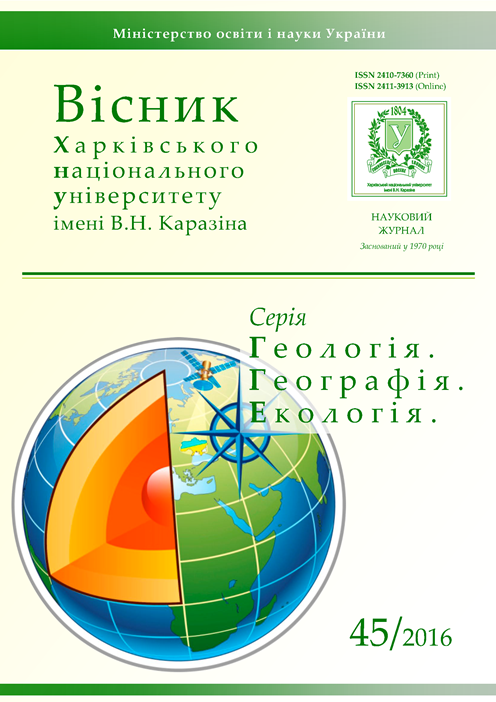Microfossils distribution in the callovian sediments of the north-western part of Dnieper-Donets depression
Abstract
The results of micropaleontological research of sponge spicules and foraminifers from the Callovian sediments in the north-west part of Dnieper-Donets depression are showed here. Spicules of sponges and foraminifers complexes of Lower, Middle and Upper Callovian sediments are described. Analysis of foraminiferal complexes allowed to allocate foraminiferal zones (Lower Callovian ‑ zone Haplophragmoides infracalloviensis; Middle Callovian ‑ zone Lenticulina cultratiformis – Lenticulina pseudocrassa and Upper Callovian ‑ zone Lenticulina tumida – Epistomina elschankaensis) and note their characteristics. New morphospecies of sponge’s spicules have been set in the study area for the first time. Analysis of sponges’ communities’ spicules enables us to assume that in the Middle and Upper Callovian basin there were sponges of Geodidae, Pachastrellidae, Tethyidae families of Tetraxonida type, and the Haliclonidae family of Cornacuspongida type. The presence of the Farreidae family sponges, Hexactinosa subtype, Amphiscophora type is also possible. In the Lower Callovian basin probably existed sponges of such families as Geodidae, Theneidae, Plinthosellidae, Haliclonidae, Axinellidae, of Hyalospongiae type and possible representatives of Amphiscophora type of Hyalonematidae family, as well as the Farreidae family of the Hexactinosa subtype. Gradual change of sponge spicules and foraminifers complexes is traced from the Lower Callovian to the Upper Callovian. The paleontological characteristics of the Callovian sediments are completed by the new data of spicule and foraminifera analysis. Ostracods and small bivalves in the complex are found. This allowed to study the biostratigraphic characteristics of the area supplement. The lithological characteristics and regularities of microfossils distribution made the existence conditions of sponge spicules, foraminifers, ostracods, bivalves small mussels possible in Callovian paleobasin reconstruction.
Downloads
References
2. Ivanik, M. M. (2003). Paleogene sponge fauna of the East European platform and adjacent regions. IGN of NAS of Ukraine, 202.
3. Kaptarenko-Chernousova, O. K. (1961). Lenticulines of Jurassic sediments of the Dnieper-Donets depression and Donbas margins. IGN of NAS of Ukraine, 103.
4. Kaptarenko-Chernousova, O. K. (1959). Jurassic sediments foraminifera of Dnieper-Donets depression. IGN of NAS of Ukraine, 121.
5. Koltun, V. M. (1959). Cornacuspongida of Northern and Far Eastern seas of the USSR. Nauka, 236.
6. Koltun, V. M. (1967). Hexactinellidae of Northern and Far Eastern seas of the USSR. Nauka, 129.
7. Koltun, V. M. (1966). Tetraxonida of Northern and Far Eastern seas of the USSR. Nauka, 112.
8. Moroz, S. A. (1996). The history of the Earth's biosphere. Zapovit, 422.
9. Nikitin, I. I., Permyakov, V. V., Permyakova, M. I. et al. (1983). New data on the stratigraphy of the Jurassic deposits of Donbas and the Dnieper-Donets depression. Kiev, AN USSR. Institute of Geological Sciences, 54.
10. Chernyshova, N. Ye. (1959). Fundamentals of paleontology. Handbook for paleontologists and geologists of the USSR. Arthropods - trilobitmorpha and crustaceans. Moscow, AN USSR, 289-291.
11. Pyatkova, D. M. (2007). Zonal division of Middle Jurassic sediments of the East European platform on foraminifers. Paleontological research in Ukraine: history, current state and prospects, 121-126.
12. Romanov, L. F. (1973). Jurassic marine bivalves of the interfluve Dnestr-Prut. Shtiintsa, 228.
13. Saidova, H. M. (1976). Benthic foraminifera of the World ocean. Nauka, 160.
14. Stanislavskiy, F. A. (1957). The fossil flora of Bathonian-Callovian deposits of the Donets Basin and the Dnieper-Donets depression. AN USSR, 130.
15. Stratigraphic schemes of Phanerozoic and Precambrian of Ukraine (1993). Kyiv, 60.
16. Stratigraphy of Upper Proterozoic and Phanerozoic of Ukraine. Vol. 1. Stratigraphy of Upper Proterozoic, Paleozoic and Mesozoic of Ukraine (2013). Kyiv, Logos, 638.
17. Stratigraphy of the USSR. Vol. VII. Jurassic (1969). Kyiv, Naukova Dumka, 216.
18. Shevchuk, O. A. (2012). Dinocysts of Callovian deposits of Central Ukraine. Algologia, 4, 409-417.
19. Shevchuk, O. A. (2007). New palynological data for characteristics of Middle Jurassic deposits of the southern board of Dnieper-Donets depression. Paleontologichnyy zbirnyk, 39, 56-65.
20. Shevchuk, O. A. (2007). The first palynological data for characteristics of Callovian and Late Albian deposits near the Kaniv town. From geology to biosphere. Problems of the present, the future prospects. Kiev, 30-31.





